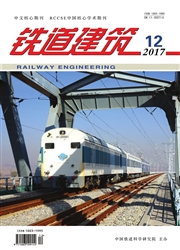

 中文摘要:
中文摘要:
黄土节理控制着黄土区地下水或者地表水的运输通道,黄土节理的发育致使黄土节理扩张为局部大的拉张裂隙,在拉张力作用下使得黄土高原地区塌滑灾害频繁发生.通过野外调查和分析,提出了黄土开挖边坡塌滑破坏可分为4 个阶段:坡脚侵蚀剥落阶段、坡顶拉裂阶段、垂直裂隙扩展阶段、边坡整体塌滑破坏阶段.结合工程实例,通过概化的三维数值分析模型,使用岩土工程软件FLAC^3D 模拟分析了在3 种降雨量条件(40 mm/d、80 mm/d、100 mm/d)下,降雨2 d 后概化模型的塌滑破坏情况,这可为工程地质条件相同地区的黄土开挖边坡塌滑变形破坏的分析以及防治提供-种有效分析范例.
 英文摘要:
英文摘要:
Transport channels of groundwater or surface water in loess area are controlled by loess joint, loess jointdevelopment leads to the loess joint expansion and becomes local large tensile cracks, collapse sliding disastershave occurred frequently under the action of tension in the loess plateau. Through the field investigation andanalysis, the collapse loess slope sliding failure can be divided into four stages: slope erosion peeling off stage, thetop tensile splitting stage, vertical crack expansion stage and slope overall collapse sliding failure stage. The collapsesliding failure situation was simulated and ion analyzed by using the geotechnical engineering softwareFLAC3D through 3d numerical analysis model in combination with practical engineering cases in three rainfallconditions (40 mm/day, 80 mm/day, 100 mm/day) after two raining days, providing an effective analysis paradigmfor analysis and control of collapse sliding deformation and failure under the same engineering geological conditionsin excavation of loess slope.
 同期刊论文项目
同期刊论文项目
 同项目期刊论文
同项目期刊论文
 期刊信息
期刊信息
